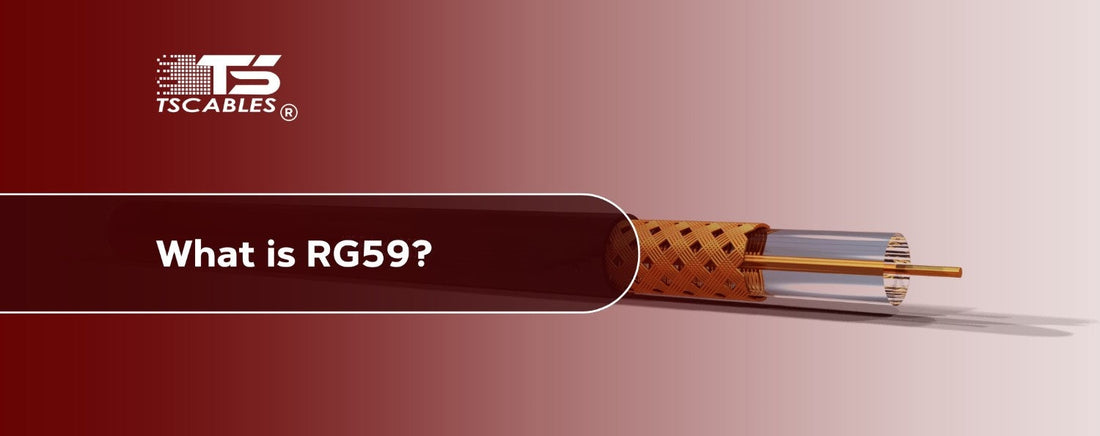RG59 is a coaxial cable that’s been around for decades. It is trusted for video and low-frequency signal transmission. It’s still popular in many settings despite not always being the go-to for high-end modern tech. And the main reason for that is the cost-effectiveness and flexibility with the ease of installation.
RG59 coaxial cable is still very much in the picture when you’re wiring a small surveillance system or connecting older TV setups. This article breaks down what it is and how it works.
It will tell you where it shines and how it stacks up next to other coax options. Let's walk through everything you need to know about RG59 coaxial cables in a clear and simple way.
RG59 Coaxial Cable: What Does It Entail?
RG59 is a coaxial cable with a copper conductor at the center and some insulating material with a metal shield. It is sold with an outer shell. This construction maintains a high signal level as it prevents external disturbances. This is also the best cable to use when a short distance is involved in signal transfer.
And it is why it has been used for decades in home video systems and analog CCTV systems. You’ll also find it in closed-circuit broadcast wiring. RG-59 coax is a lighter and less rigid type of coax as compared to some of its newer relatives. This enables it to be installed in small areas easily.
However, with high-frequency signals or long channel routes, the question is frequently raised about whether to go with RG6 or RG59. Let’s go through the different applications of RG59 to get a better idea of it.
Different Applications of RG59 Coaxial Cable
It’s important to understand that RG-59 isn't one-size-fits-all before diving into use cases. People often ask things like, “Does the type of coaxial cable matter?” Yes, it does. But RG-59 cable still holds its own in many daily uses. It is especially the case where speed and distance aren’t deal-breakers.
Analog CCTV Systems
The most common place you’ll still see RG59 cable coaxial is in older CCTV systems. These systems rely on analog signal. RG-59 coax cable handles that well without breaking the bank.
Basic TV Setups
RG59 still shows up for simpler home entertainment setups, especially with standard definition signals. Some people still use cable rg59 for shorter runs, when you look into the type of coaxial cable for TV or even the type of coaxial cable for HDTV.
Short-Distance Video Transmission
Video monitors in schools, churches, or security rooms still rely on coaxial cable RG-59. It's not heavy-duty, but for under 100 feet, it gets the job done with little trouble.
RF Signal Connections
Radio frequency systems like ham radios or internal audio setups often choose RG-59 U because it's easy to route and doesn’t need advanced shielding for the low-frequency signals.
Internal Security Cameras
Even some modern systems use rg59 combined with power cables to bundle power and video together. This keeps things tidy for installers who like one cable instead of two.
Key Specifications of RG59 Coaxial Cable
Technical specs might sound boring. Nevertheless, knowing what you’re working with helps you avoid headaches later. Let’s go over some of the important things to keep in mind regarding the key specifications of RG59 coaxial cables.
Cable Diameter
RG59 diameter usually measures around 6.15 mm or 0.24 inches. That’s smaller than RG6. This feature makes it easier to bend around corners or route through walls.
Impedance
The standard RG-59 impedance is 75 ohms. This matches most analog video equipment. However, it’s not as efficient for broadband internet. This is the reason why RG-59 vs RG-6 matters in modern setups.
Frequency Range
RG59 coaxial cable specifications usually top out around 50 MHz for a quality video signal. That’s why it’s fine for analog but not ideal for digital TV or the internet.
Shielding
Most rg59 coaxial cables offer braided shielding. This feature makes it good for low-frequency applications. However, an important thing to note is that it may not hold up compared to thicker cables like RG6 in high-interference areas.
Wrapping Up
RG59 coaxial cable is still useful if you're dealing with analog systems or short distances. It is also an option worth considering for tighter spaces. It’s flexible and affordable with a simple installation. But the question of RG6 vs RG59 coaxial cable should always depend on what you’re wiring and how far it needs to go.
Choosing between different types of coaxial cable is more than just about numbers. You need to consider the functions and features to find the right one according to your needs and preferences.
Keep in mind RG59 might not be the flashiest cable around. That being said, it still has its place. It works well for short video runs and analog CCTV as well as simple AV needs. It saves time and money if you are able to use it in the right manner.
Partner with TS Cables for dependable RG59 coaxial cables that get the job done cleanly and affordably.
FAQs
Are RG59 and RG6 connectors the same?
Not always. They may look similar. However, the cable sizes differ. It is the main reason why the fit might not work.
Is RG59 better for CCTV?
Yes, for analog systems. But for HD cameras, RG6 or other cables may offer better signal clarity.
Can I use RG59 for the internet?
Not recommended. It doesn’t carry high-frequency signals well. There is also a good chance you’ll likely lose speed.
What's the difference between RG59 and RG6?
RG6 is thicker and carries higher frequencies. This feature makes it better for digital signals. RG59 is thinner and works best for analog.
Are RG6 and RG59 interchangeable?
Sometimes, but it depends on the connector and signal type. Don’t swap without checking compatibility.






